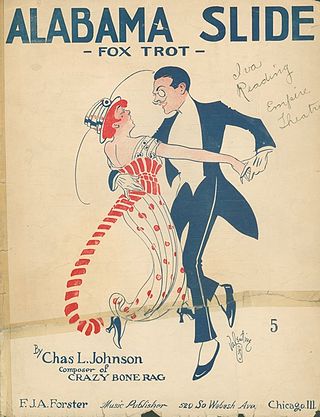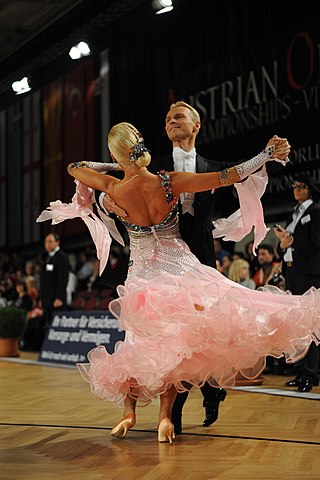
Ballroom dance is a set of partner dances, which are enjoyed both socially and competitively around the world, mostly because of its performance and entertainment aspects. Ballroom dancing is also widely enjoyed on stage, film, and television.
In some types of partner dance, lead and follow are designations for the two dancers' roles in a dance pairing. The leader is responsible for guiding the couple and initiating transitions to different dance steps and, in improvised dances, for choosing the dance steps to perform. The leader communicates choices to the follower, and directs the follower by means of subtle physical and visual signals, thereby allowing the pair to be smoothly coordinated.

The foxtrot is a smooth, progressive dance characterized by long, continuous flowing movements across the dance floor. It is danced to big band music. The dance is similar in its look to waltz, although the rhythm is in a 4
4 time signature instead of 3
4. Developed in the 1910s, the foxtrot reached its height of popularity in the 1930s and remains practiced today.

A redowa is a dance of Czech origin with turning, leaping waltz steps that was popular in European ballrooms.
This is a list of dance terms that are not names of dances or types of dances. See List of dances and List of dance style categories for those.

In ballroom dancing, directions of progressive movement, in particular directions of steps, can be indicated either in relation to the room or in relation to the body position. Directions of turns, although there are only two of them, may also be indicated in several ways.

The quickstep is a light-hearted dance of the standard ballroom dances. The movement of the dance is fast and powerfully flowing and sprinkled with syncopations. The upbeat melodies that quickstep is danced to make it suitable for both formal and informal events. Quickstep was developed in the 1920s in New York City and was first danced by Black Americans. Its origins are in combination of slow foxtrot combined with the Charleston, a dance which was one of the precursors to what today is called swing dancing.
The closed change is a Pre-Bronze, or newcomer waltz figure, performed in closed position. Changes may start of the right foot or left foot, moving forward or backward. This makes four different types of closed changes. Combining two changes results in a box step. In right changes the man starts from the right foot, while in left ones the man starts from the left foot.
The basic step, basic figure, basic movement, basic pattern, or simply basic is the dance move that defines the character of a particular dance. It sets the rhythm of the dance; it is the default move to which a dancer returns, when not performing any other moves. More formally, it can be defined as a "rhythmic step pattern" in the form of a "consistent and recurring grouping of weight changes" between the feet which is rhythmic and repeated for the length of a song. For some dances it is sufficient to know the basic step performed in different handholds and dance positions to enjoy it socially.

The cha-cha-cha, is a dance of Cuban origin. It is danced to the music of the same name introduced by the Cuban composer and violinist Enrique Jorrin in the early 1950s. This rhythm was developed from the danzón-mambo. The name of the dance is an onomatopoeia derived from the shuffling sound of the dancers' feet when they dance two consecutive quick steps that characterize the dance.
Samba de Gafieira is a partner dance to various Brazilian samba musical rhythms. Unlike street and club forms of Brazilian samba, it evolved as a ballroom dance.
The country/western two-step, often called the "Texas two-step" or simply the "two-step," is a country/western dance usually danced to country music in common time. "Traditional [Texas] two-step developed, my theory goes, because it is suited to fiddle and guitar music played two-four time with a firm beat [found in country music]. One-two, one-two, slide-shuffle. The two-step is related to the polka, the Texas waltz, and the jitterbug.
The Texas two-step is the same step known to ballroom dancers as the international fox-trot. Except for the one-step, which is just that, most Texas dances are variations of a two-step, also called a half-step, which is simply a step-close-step. The Texas two-step is generally done with two long steps and a step-close-step to two-four time. Speeded up, it's a shuffle or double shuffle, but still a two-step.

The chassé is a dance step used in many dances in many variations. All variations are triple-step patterns of gliding character in a "step-together-step" pattern. The word came from ballet terminology.

Contra body movement is used in ballroom dances, such as waltz, foxtrot, tango, and quickstep. It comprises turning the body against the movement of the legs: either moving forward with the right foot and the left hip and shoulder, or vice versa.
The counter promenade position is a dance position in ballroom and other dances. It is described differently in various dance categories, but essentially it is the opposite of the promenade position.
Valse à deux temps, waltz à deux temps, also Valse à deux pas or Valse Russe was a waltz of Russian origin introduced in France in the mid-19th century.
The whisk is a ballroom dance step used in the waltz and American style Viennese waltz. It is one of several ways to get into promenade position and is used to turn dancers around corners or change their direction on the dance floor. It can be performed after a reverse turn.
Figures of Argentine tango are elements of Argentine tango.
There are several types of lock step in waltz dancing, including International Standard waltz. A "lock step" is when the moving foot approaches to the standing foot and crosses in front of or behind it, creating a "check" position.








